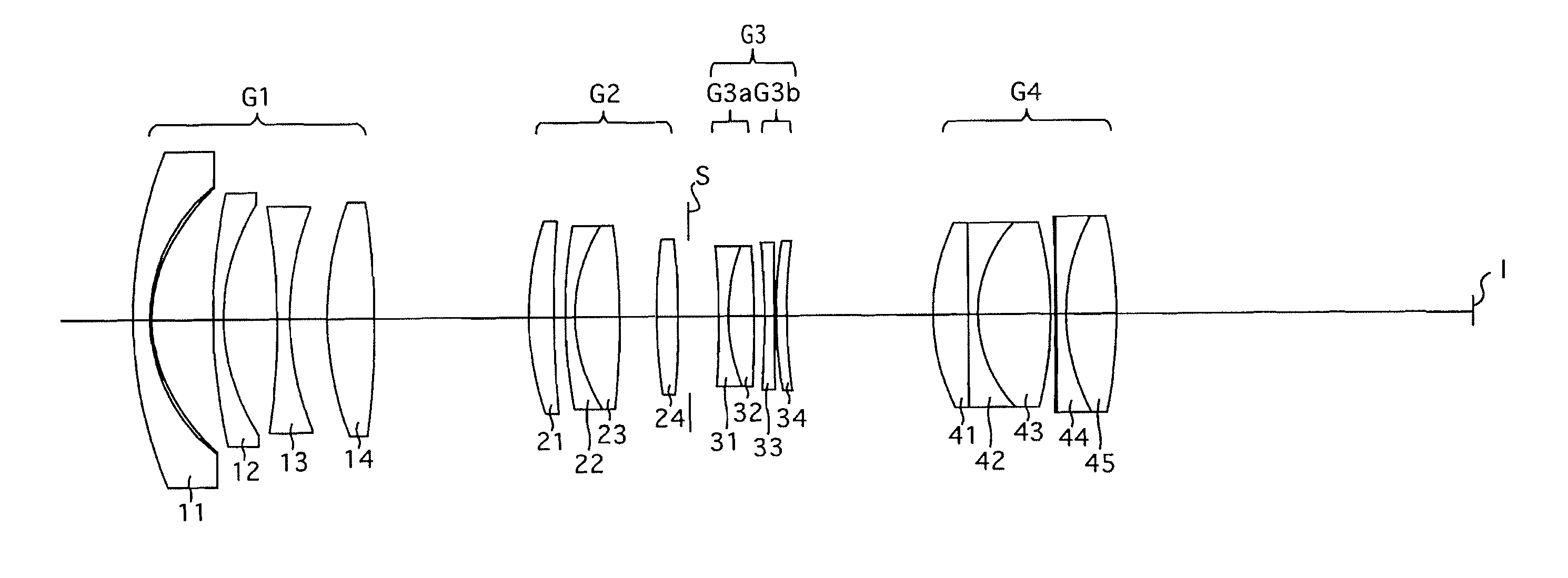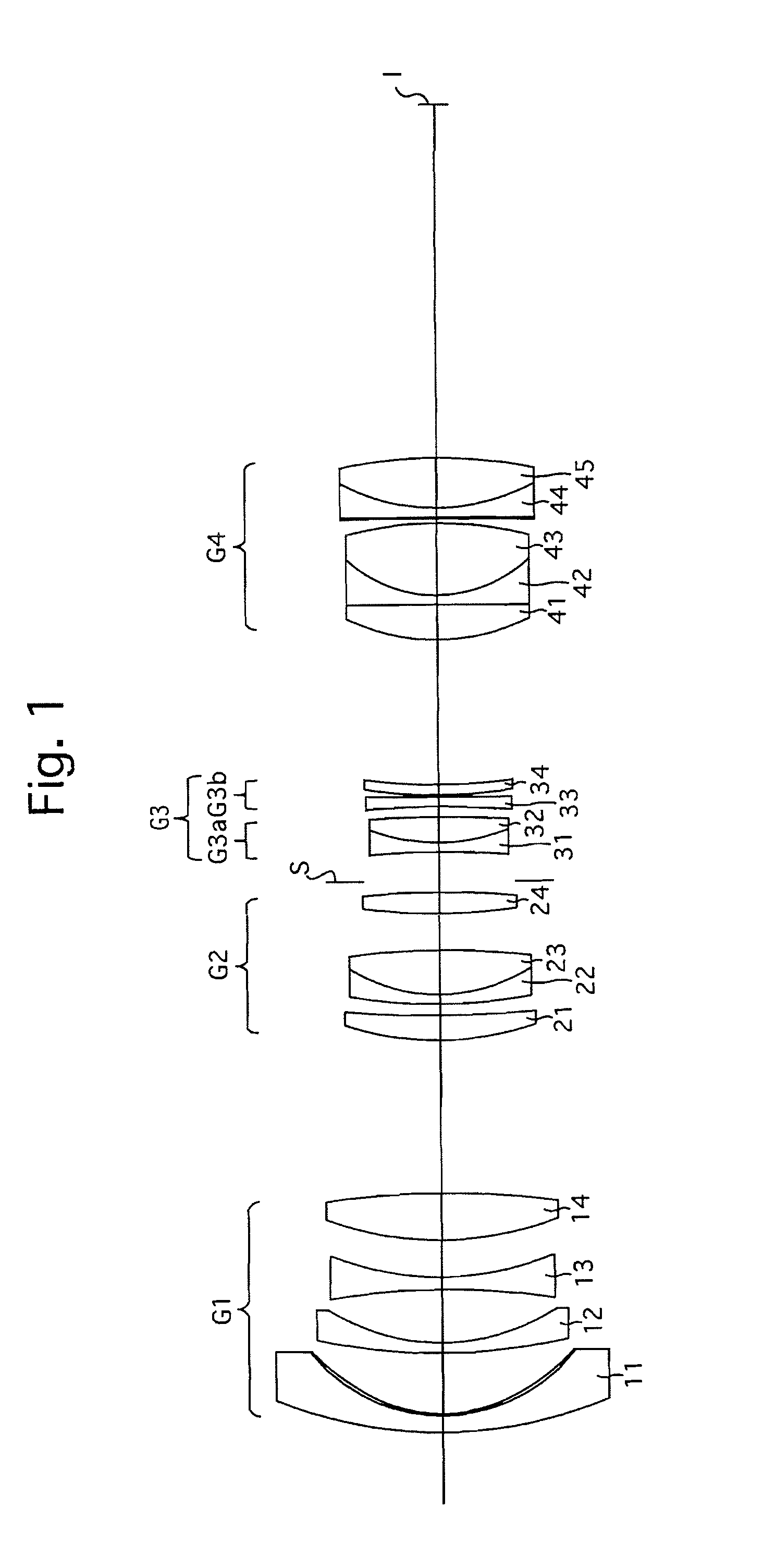Zoom lens system
a zoom lens and lens group technology, applied in the field of zoom lens system, can solve the problems of enlargement of the entire zoom lens system, insufficient optical quality, and increased burden on the drive mechanism of the image stabilizing lens group, so as to reduce the burden on the drive mechanism, improve the optical quality, and facilitate aberration correction
- Summary
- Abstract
- Description
- Claims
- Application Information
AI Technical Summary
Benefits of technology
Problems solved by technology
Method used
Image
Examples
numerical embodiment 1
[0266]FIGS. 1 through 10C and Tables 1 through 5 show a first numerical embodiment of the zoom lens system according to the present invention. FIG. 1 shows a lens arrangement of the first numerical embodiment of the zoom lens system, at the short focal length extremity when focused on an object at infinity. FIGS. 2A, 2B, 2C and 2D show various aberrations that occurred in the lens arrangement shown in FIG. 1, at the short focal length extremity when focused on an object at infinity. FIGS. 3A, 3B and 3C show lateral aberrations that occurred in the lens arrangement shown in FIG. 1, at the short focal length extremity when focused on an object at infinity. FIGS. 4A, 4B, 4C and 4D show various aberrations that occurred in the lens arrangement shown in FIG. 1, at an intermediate focal length when focused on an object at infinity. FIGS. 5A, 5B and 5C show lateral aberrations that occurred in the lens arrangement shown in FIG. 1, at an intermediate focal length when focused on an object a...
numerical embodiment 2
[0275]FIGS. 11 through 20C and Tables 6 through 10 show a second numerical embodiment of the zoom lens system according to the present invention. FIG. 11 shows a lens arrangement of the second numerical embodiment of the zoom lens system, at the short focal length extremity when focused on an object at infinity. FIGS. 12A, 12B, 12C and 12D show various aberrations that occurred in the lens arrangement shown in FIG. 11, at the short focal length extremity when focused on an object at infinity. FIGS. 13A, 13B and 13C show lateral aberrations that occurred in the lens arrangement shown in FIG. 11, at the short focal length extremity when focused on an object at infinity. FIGS. 14A, 14B, 14C and 14D show various aberrations that occurred in the lens arrangement shown in FIG. 11, at an intermediate focal length when focused on an object at infinity. FIGS. 15A, 15B and 15C show lateral aberrations that occurred in the lens arrangement shown in FIG. 11, at an intermediate focal length when...
numerical embodiment 3
[0277]FIGS. 21 through 30C and Tables 11 through 15 show a third numerical embodiment of the zoom lens system according to the present invention. FIG. 21 shows a lens arrangement of the third numerical embodiment of the zoom lens system, at the short focal length extremity when focused on an object at infinity. FIGS. 22A, 22B, 22C and 22D show various aberrations that occurred in the lens arrangement shown in FIG. 21, at the short focal length extremity when focused on an object at infinity. FIGS. 23A, 23B and 23C show lateral aberrations that occurred in the lens arrangement shown in FIG. 21, at the short focal length extremity when focused on an object at infinity. FIGS. 24A, 24B, 24C and 24D show various aberrations that occurred in the lens arrangement shown in FIG. 21, at an intermediate focal length when focused on an object at infinity. FIGS. 25A, 25B and 25C show lateral aberrations that occurred in the lens arrangement shown in FIG. 21, at an intermediate focal length when ...
PUM
 Login to View More
Login to View More Abstract
Description
Claims
Application Information
 Login to View More
Login to View More - R&D
- Intellectual Property
- Life Sciences
- Materials
- Tech Scout
- Unparalleled Data Quality
- Higher Quality Content
- 60% Fewer Hallucinations
Browse by: Latest US Patents, China's latest patents, Technical Efficacy Thesaurus, Application Domain, Technology Topic, Popular Technical Reports.
© 2025 PatSnap. All rights reserved.Legal|Privacy policy|Modern Slavery Act Transparency Statement|Sitemap|About US| Contact US: help@patsnap.com



